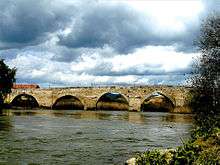Zadorra
| Zadorra | |
|---|---|
 The Zadorra at Armiñon | |
| Country | Spain |
| Basin | |
| Main source |
Basque Mountains 1,045 m (3,428 ft) |
| River mouth | Ebro River |
| Basin size | 1,361.28 km2 (525.59 sq mi)[1] |
| Physical characteristics | |
| Length | 78.1 km (48.5 mi)[2] |
| Discharge |
|
The Zadorra is a river tributary of the Ebro in the Basque Country at the north of the Iberian Peninsula. The river flows across province Álava all along (with the exception of Burgos' exclave La Puebla de Arganzon) till it pours into the Ebro near Miranda de Ebro in Burgos' lands. The river's water volume is the largest in Álava, with its basin being the most extensive in the province. Nowadays it provides by means of the Zadorra Reservoir System (comprising reservoirs Uribarri-Ganboa, Urrunaga and Albina) water supply for Vitoria and half of the Basque Autonomous Community.
The river rises in the slopes of the Entzia Plateau at the spring known as Los Corrales (municipality of San Millan/Donemiliaga), meandering thereafter across the Alavan Plains to the west (loops around Salvatierra/Agurain) past Vitoria by the north, where it takes a turn to the south heading to the Ebro through La Puebla de Arganzon.
Landmarks
- The village and iconic castle of Gebara sit by the river on its middle stage.
- The Zadorra Reservoir System starting in Uribarri-Ganboa (built as of 1947).
- The Battle of Vitoria took place on a stretch extending 18 kilometres (11 mi) on the banks of Zadorra from La Puebla de Arganzon to Trespuentes to Mendoza.[3]
- The site of old Basque-Roman town Iruña-Veleia is across the river from Traspuentes.
Pollution
The Zadorra is the most important river in Álava and is also the most polluted. It ranks in the top six polluted rivers in the Basque Country.
More than 2,754 waste disposals have been authorised, 1,783 (65%) of which are urban and 960 (35%) of to which are industrial. From the 960 industries 89 of them are subject integrated environmental authorization. Unauthorized waste disposal also must be taken into account for the pollution. Additionally, waste dumped by industries is often more polluted than it should be.
The oxygen levels in the Zadorra are below the standards required for the wildlife in the river. The river's situation is also aggravated by the presence of toxins. The level of toxins is above the amount allowed by the European Union. Fifteen wastewater treatment plants have helped stopping the advance of the pollution in the river. The kind of insects that nest in the river are an indicator of the degradation of the Zadorra. Because the insects show in the top of the river what is happening in the bottom of it. In addition, nitrates have appeared in the river in despite of the amount of nitrates is quite low there should not be any nitrates.
In 2008 the Ebro's hydrografic confederation published a report about some of the rivers around the Ebro, including the Zadorra river. The investigation, which measured pollution in the rivers over four years, started in 2004. The report showed that the amount of pollution found in the river was well over the permitted amount. As a result, the municipalities have started some control programmes for the authorization of waste disposal. The control programmes have brought about some reduction in pollution.
References
- ↑ "ANÁLISIS MORFOMÉTRICO DE LA CUENCA Y DE LA RED DE DRENAJE DEL RÍO ZADORRA Y SUS AFLUENTES APLICADO A LA PELIGROSIDAD DE CRECIDAS" (PDF). Asociación de Geografos Españoles. Retrieved 2010-01-28. Site in Spanish
- ↑ "El Agua en Álava". DFA. Retrieved 2010-01-28. Site in Spanish
- ↑ "Batalla de Vitoria". EuskoMedia Fundazioa. Retrieved 2010-01-28. Site in Spanish
Coordinates: 42°40′03″N 2°53′59″E / 42.66750°N 2.89972°E
